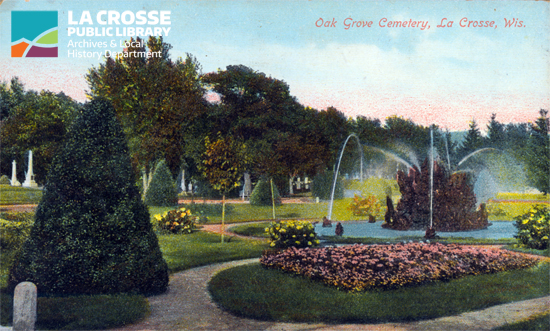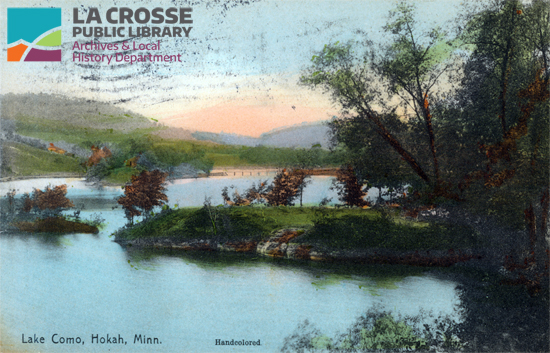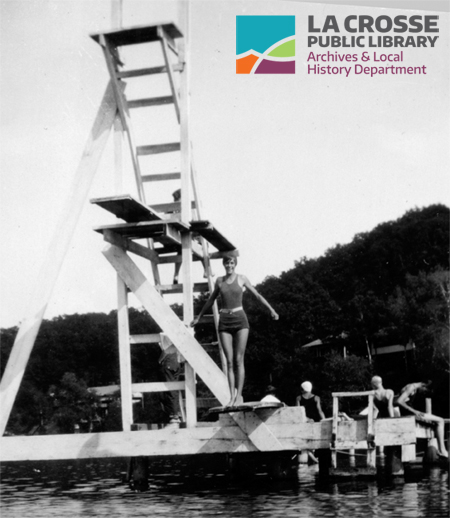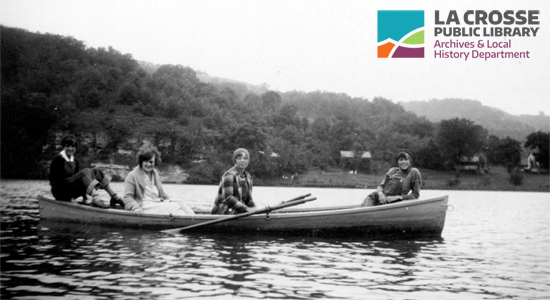
Prosper Steves and Loretto the Cork Woman
(written by Dr. Les Crocker, Emeritus Professor of Art History)
Lumber barons, hardware dealers and soft goods sellers made huge fortunes in the early years of La Crosse, but not all those that tried succeeded in their efforts. One such man was Prosper Steves, flower seller and creator of the fountains and landscaping in Oak Grove Cemetery.
Born 1847 in Rochelle, New York, Prosper, or “Pro” for short, came west with his family in 1850 to what would be La Crosse when he was three years old. His father Elijah Steves was a carpenter who must have been part of the balloon frame revolution in house building. Young “Pro” as he was called apprenticed in the shop of the Smith Company on South Front Street, a foundry and machine shop. Even at an advanced ago of 87, he continued to maintain a small shop, equipped with machinery that he tinkered with as a hobby.
Prosper first appears in the 1876 city directory not as a carpenter but selling “floral goods” at a store on Main Street but that was an early date for a flower shop to succeed in the town. By this time La Crosse was no longer a frontier town, and in that decade seven towered mansions would be built in the city. However, Prosper continued his love of plants as the superintendent of the floral shop at Oak Grove Cemetery.
By the next published city directory in 1878, Steves advertised selling pumps at his home on the east side of South 8th Street, south of Division Street. In 1881 he listed himself as a plumber and in 1884 he advertised as a plumber and gas fitter. Indoor plumbing was being used in houses of the wealthy as was 'city gas' for lighting. Both occupations were new and may not yet have been prosperous enough.
During this time, he was employed by the Oak Grove Cemetery to improve the landscaping and general appearance of the cemetery. It was a time of change as midwestern burial grounds morphed from the New England churchyard type to large areas of “natural beauty” with tree sheltered walkways, distant, overlooks, rocky niches and rustic fences and furniture.

A scene in Oak Grove Cemetery, circa 1880, taken by Elmer & Tenney photographers
Butterfield’s History of La Crosse County, 1881 singles out the cemetery for its fine fountains and rustic rock work which used Steves’ plumbing and mechanical prowess.
“The entrance to the cemetery is at the southwest corner, where a beautiful fountain has been placed in the midst of a circle which receives the water from a score of jets, whose musical plashing into the pool beneath them gives a most refreshing sense of coolness. The center is ornamented with a number of spires of rock work, the light, irregular, air pinnacles which seem modeled after some of the battlemented towers of the storied Rhine. It was designed by Prosper Steves.”

A colorized postcard of the fountain Prosper Steves designed and built for Oak Grove Cemetery.
The “spires of rock work” are made of a local fossilized alga that was very popular to use in decorative walls, birdbaths, fishponds, flowerbed edging, and religious shrines from the 1880s until the 1930s. Steves undoubtedly used his knowledge of pumps and plumbing to create the new entrance to Oak Grove.
As supervisor of the cemetery one would think Steves led a quiet life, but probably the strangest moment of Steves’ life came late one night in October of 1884. Frank Burton, a popular businessman in La Crosse was killed by Scotty Mitchell, a river man with a grudge against Burton during a political parade. Mitchell was forcibly taken out of jail by a crowd of unrecorded people and lynched. After the deed had been done, there were questions about what to do with the body of Mitchell.
Undoubtedly with support from the city fathers, Mitchell's body was removed from the Tillman Funeral Parlor late at night. Joseph Losey, president of Oakwood Cemetery and a respected lawyer, Andrew Fontish, sexton of the cemetery, Prosper Steves, and an unnamed wagon driver buried Mitchell in a shallow grave in Oakwood Cemetery, which later was renamed Oak Grove Cemetery. Evidence of the burial was covered up and the public soon forgot Mitchell.
In 1914 an expansion of Oak Grove cemetery was planned. Steves was still cemetery superintendent and told the story of Mitchell's burial, but could not say exactly where it had been. The original group had gone to great lengths to disguise the location and thirty years had passed with many changes so Steves’ confusion over the location is understandable. The expansion went forward and the location of Mitchell’s burial is still unknown.
In 1885 Steves was Superintendent of the Oak Grove Greenhouses and is listed at 1605 La Crosse Street, the house for the cemetery caretaker in the 1885 and 1888 city directories. His advertisement in the city directory shows he has returned to his love of flowers and the mention of telegraph and telephone connections indicates he is accepting the technological changes in business life.
“The Largest Growers of Flowers West of Milwaukee.All kinds of Plants and Flowers for Sale, in their Season, at Wholesale or Retail. Floral Designs for Funerals, Weddings or Parties made up on Short Notice.Orders from abroad promptly attended to.Address, P. E. STEVES, Supt.,Telegraph and Telephone Connections. LA CROSSE, WIS.”In 1890 he advertised as a landscape gardener, but in 1891 and 1893 he was making trunks at 517 South 8th Street, the space next to his house. He sold his trunk manufacturing business to Herken and in 1895 turned again to machine tinkering with a new, cutting edge, travel technology that would change the local world.
Bicycles were the poor man's horse. Horses were expensive to own and required a lot of maintenance. Bicycles gave both genders a wider range of possibilities. The trolley lines weren't always convenient and weren't very exciting at any time. Bicycles turned loose the young adults of the city like nothing before and would only be duplicated twenty years later when automobiles became cheaper. Bicycles began the breakup of ethnic neighborhoods as people traveled farther to new shops or to more distant jobs.
The 1895 and 1897 city directories carry the same ad for “Steves, P. E. Bicycle Manufacturer and Repairer. All work turned out guaranteed strictly first class. Prices for work reasonable. All kinds of bicycle repairs kept constantly on hand. Shops 517 S. 8th, res 515 S. 8th.” In these same years his brother Justin, a streetcar conductor on the La Crosse City Railway, ran a bicycle repair shop on the north side.
The year of 1895 was a phenomenal year for the bicycle revolution. There were eleven bicycle dealers listed in the city directory, along with a bicycle livery (rent and store bikes), two bicycle manufacturers, the John James Co. (foundry) at corner of Front and King streets and Prosper E. Steves at 517 S. 8th St. Also there were six listings for bicycle repair and one for supplies.
In 1897 the number of bicycle dealers listed is thirteen and three manufacturers listed. Seven repairers advertised. Bicycles are relatively simple machines. The tools needed for repair are common and inexpensive so it was an easy second job for men. National manufacturers quickly replaced the local shops who couldn't compete in price.

A colorized postcard of Lake Como, south of Hokah, Minnesota, where the Steves family operated Idlewild, a summer resort with beaches, cottages and boats.
In 1900 Steves is out of the bicycle business and advertises as the proprietor of Idlewild, a boating and fishing resort on Lake Como in Hokah, Minnesota, but he still maintained his residence at 515 South 8th in La Crosse. Steves built the dam and operated the resort with cottages, bathing beach and boats. The Milwaukee Railroad ran excursion trains from La Crosse to Hokah, a distance of 10 miles. Running a summer lake resort wasn't a full-time job, and he continued to supervise the Oak Grove Cemetery greenhouses. His brother owned and operated a successful boat livery on French Island and a summer resort.

A woman on a diving platform at Lake Como. Courtesy of the Gantert/Stickler Family.

Members and/or friends of the Gantert family take a ride in the rowboat on Lake Como. Courtesy of the Gantert/Stickler family.
In the twentieth century the family star appears at the opening of the first public bath house in La Crosse on July 4th, 1904. The July 2, 1904, Tribune article says “At 2:30 Lady Smoretta, the champion lady swimmer of the world will have a half hour swimming exhibition.” An article in the July 5th Tribune refers to “Lorreto the cork woman”, famous for her swimming exhibitions in Lake Como. Lady Smoretta and Lorreto the Cork Woman were the alter egos of 22-year-old Laura Steves, daughter of Prosper.
In 1909 the dam at Lake Como in Hokah failed and significant damage was done to the rail yards and other downstream businesses. It was never rebuilt although proposals are made occasionally. With the end of Lake Como, Idlewild was no longer a summer resort and Prosper continued as superintendent at Oak Grove.
Nothing more substantial is heard of the Steves family until Aug. 12, 1912, when Sarah (Mrs. Prosper E.) Steves died in Hokah. Six years later in 1918, his daughter Laura Steves Ross died at age 36. Proper lived to age 90 in 1938 and was buried with his family in Oak Grove Cemetery, section 14. He arrived in La Crosse when it was a very small town and contributed to its growth and saw the world change. Not all early settlers became rich, most people never seemed to catch the moment that would bring them fame and fortune.
